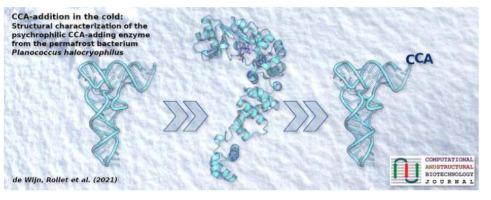Computational and Structural Biotechnology Journal ( IF 6 ) Pub Date : 2021-10-21 , DOI: 10.1016/j.csbj.2021.10.018 Raphaël de Wijn 1 , Kévin Rollet 1, 2 , Felix G M Ernst 2 , Karolin Wellner 2 , Heike Betat 2 , Mario Mörl 2 , Claude Sauter 1

|
CCA-adding enzymes are highly specific RNA polymerases that add and maintain the sequence C–C–A at tRNA 3‘–ends. Recently, we could reveal that cold adaptation of such a polymerase is not only achieved at the expense of enzyme stability, but also at the cost of polymerization fidelity. Enzymes from psychrophilic organisms usually show an increased structural flexibility to enable catalysis at low temperatures. Here, polymerases face a dilemma, as there is a discrepancy between the need for a tightly controlled flexibility during polymerization and an increased flexibility as strategy for cold adaptation. Based on structural and biochemical analyses, we contribute to clarify the cold adaptation strategy of the psychrophilic CCA-adding enzyme from Planococcus halocryophilus, a gram–positive bacterium thriving in the arctic permafrost at low temperatures down to –15°C. A comparison with the closely related enzyme from the thermophilic bacterium Geobacillus stearothermophilus reveals several features of cold adaptation – a significantly reduced amount of alpha-helical elements in the C–terminal tRNA-binding region and a structural adaptation in one of the highly conserved catalytic core motifs located in the N-terminal catalytic core of the enzyme.
中文翻译:

在寒冷中添加 CCA:来自永久冻土细菌 Planococcus halocryophilus 的嗜冷 CCA 添加酶的结构特征
添加 CCA 的酶是高度特异的 RNA 聚合酶,可在 tRNA 3'-末端添加并维持 C-C-A 序列。最近,我们可以揭示这种聚合酶的冷适应不仅以酶稳定性为代价,而且以聚合保真度为代价。来自嗜冷生物的酶通常表现出更高的结构灵活性,从而能够在低温下进行催化。在这里,聚合酶面临着两难选择,因为在聚合过程中需要严格控制的灵活性与作为冷适应策略的增加的灵活性之间存在差异。基于结构和生化分析,我们有助于阐明来自嗜盐蓝球藻的嗜冷 CCA 添加酶的冷适应策略,一种革兰氏阳性细菌,可在低至 –15°C 的低温下在北极永久冻土中繁殖。与来自嗜热细菌Geobacillus stearothermophilus的密切相关的酶的比较揭示了冷适应的几个特征——C端 tRNA 结合区域中 α 螺旋元件的数量显着减少,以及一个高度保守的催化核心中的结构适应基序位于酶的 N 端催化核心。



























 京公网安备 11010802027423号
京公网安备 11010802027423号